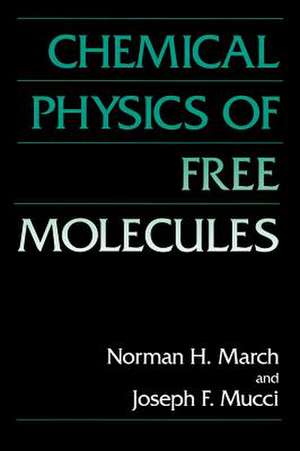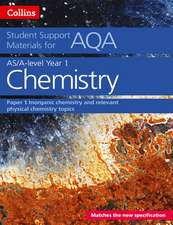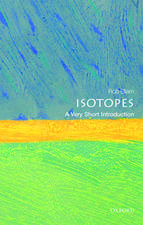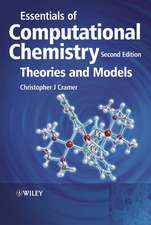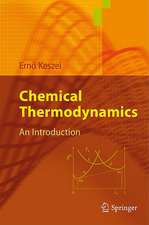Chemical Physics of Free Molecules
Autor Norman H. March, J.F. Muccien Limba Engleză Hardback – 31 aug 1993
| Toate formatele și edițiile | Preț | Express |
|---|---|---|
| Paperback (1) | 651.19 lei 6-8 săpt. | |
| Springer Us – 29 apr 2013 | 651.19 lei 6-8 săpt. | |
| Hardback (1) | 659.20 lei 6-8 săpt. | |
| Springer Us – 31 aug 1993 | 659.20 lei 6-8 săpt. |
Preț: 659.20 lei
Preț vechi: 775.53 lei
-15% Nou
Puncte Express: 989
Preț estimativ în valută:
126.15€ • 136.98$ • 105.97£
126.15€ • 136.98$ • 105.97£
Carte tipărită la comandă
Livrare economică 22 aprilie-06 mai
Preluare comenzi: 021 569.72.76
Specificații
ISBN-13: 9780306442704
ISBN-10: 0306442701
Pagini: 393
Ilustrații: XX, 393 p.
Dimensiuni: 178 x 254 x 24 mm
Greutate: 0.94 kg
Ediția:1993
Editura: Springer Us
Colecția Springer
Locul publicării:New York, NY, United States
ISBN-10: 0306442701
Pagini: 393
Ilustrații: XX, 393 p.
Dimensiuni: 178 x 254 x 24 mm
Greutate: 0.94 kg
Ediția:1993
Editura: Springer Us
Colecția Springer
Locul publicării:New York, NY, United States
Public țintă
ResearchCuprins
One Chemical Concepts and Experimental Techniques.- Two The Nature of Bonding in Diatoms.- Three Molecular Interactions.- Four Electron Density Description of Molecules.- Five Molecular Parameters Determined by Spectroscopic Methods.- Six Molecular Orbital Methods and Polyatomic Molecules.- Seven Chemical Reactions, Dynamics, and Laser Spectroscopy.- A1.1. Wave Functions for the Hydrogen Atom.- A1.2. The Periodic Table and Atomic Ground States.- A1.3. Total Energies of Heavy Atomic Ions—Coulomb Field Model.- A1.4. Orthogonality of Solutions of the Schrödinger Equation.- A2.1. Variation Principle.- A2.3. Born-Oppenheimer Approximation.- A2.4. Slater- and Gaussian-Type Orbitals.- A2.6. Virial and Hellmann-Feynman Theorems.- A3.1. Topics Relevant to the Treatment of Intermolecular Forces.- A3.2. Bibliography for Further Study of Intermolecular Forces.- A4.1. The Correspondence between Cells in Phase Space and Quantum-Mechanical Energy Levels.- A4.2. The Kinetic Energy Density of an Inhomogeneous Electron Gas.- A4.3. The Chemical Potential, Teller’s Theorem, and Scaling of Energies of Homonuclear Diatoms.- A4.4. The Self-Consistent Field in the Helium Atom.- A4.5. The Self-Consistent Field Treatment of Binding Energies of Heavy Positive Atomic Ions.- A4.6. The Hartree-Fock Self-Consistent Field Method.- A4.7. The Dirac-Slater Exchange Energy and Existence of a One-Body Potential Including Both Exchange and Correlation.- A4.8. Proof that the Ground-State Energy of a Molecule Is Uniquely Determined by the Electron Density.- A4.9. Modeling of the Chemical Potential in Hydrogen Halides and Mixed Halides.- A4.10. X-Ray Scattering by Neon-Like Molecules.- A4.11. Two-Center Calculations from the Thomas-Fermi Theory.- A5.1. Rotational Energy Levels of Some Simple Classes ofMolecules: The Symmetric Rotor.- A5.2. The Rotational Partition Function in Relation to Spectroscopic Intensities.- A5.3. Normal Modes of Vibration of Molecules.- A5.4. The Franck-Condon Principle.- A5.5. Time-Dependent Perturbation Theory and Selection Rules for Electric Dipole Transitions in Atoms.- A5.6. Spin-Orbit Coupling.- A5.7. Dirac’s Relativistic Wave Equation for One Electron.- A5.8. Relativistic Electron Density Theory for Molecules Composed of Heavy Atoms.- A6.1. The Jahn-Teller Effect.- A6.2. Koopmans’ Theorem and Its Use in Interpreting Photoelectron Spectra.- A7.1. Symmetry Arguments for Electrocyclic Reactions.- A7.2. Chemical Reactions: Arrhenius’ Empirical Work, the Collision Theory, and the Absolute Rate or Transition State Theory.- Advanced Problems.- AI. Some Advanced Aspects of Quantum-Mechanical Perturbation Theory.- AII. The Formation of Acetylene from Two CH Fragments.- AIII. MacDonald’s Theorem.- AIV. Spectroscopic Nomenclature.- AV. The Wentzel-Kramers-Brillouin Semiclassical Method for Calculating Eigenvalues for Central Fields.- AVI. Electron Correlation in the Helium Atom and the Slow Convergence of Configuration Interaction.- Further Problems.- References.
